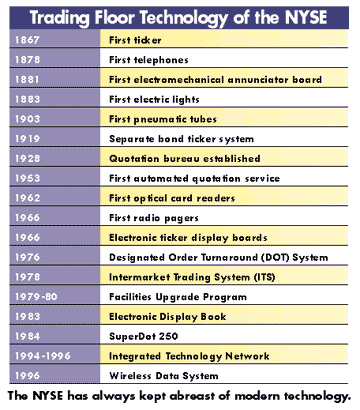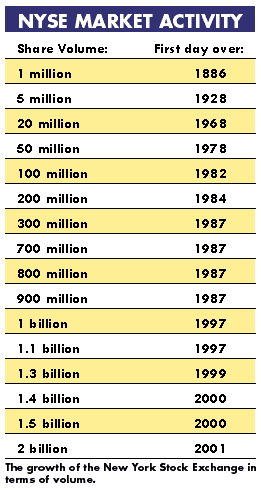
HOT TOPICS LIST
- Strategies
- Stocks
- Buy
- Investing
- Brokers
- Psychology
- Interviews
- Accumulate
- Sell
- Hold
- Spotlight
- Websites
- Candlestick Corner
- Gold & Metals
- Options Trading
LIST OF TOPICS
MONEY MANAGEMENT
The Market Guru of The Gilded Age
05/30/01 03:08:30 PM PSTby James Maccaro
Over a century ago, James K. Medbery insisted that earnings and interest rates matter. He was right then, and he still is.
| Have you ever attempted to understand the financial markets, where trillions of dollars are gained and lost in a matter of months? Have you ever wondered how the market of today is different from that of the 19th century, when the New York Stock Exchange started? The stock market exists for the sake of making money and always has. Nor will that change, whether we are looking at the markets of the 19th century or the 21st. And there are other factors that have not changed. Even the contemporary stock market gurus you see on television, on popular investment shows such as Wall $treet Week with Louis Rukeyser, are simply following in the footsteps of early Wall Street commentators such as James K. Medbery. This writer, now mostly forgotten, offered surprisingly sophisticated analysis of the stock market, most notably in his Men And Mysteries Of Wall Street, published in 1870, as well as in articles published in Harper's Weekly, The Atlantic Monthly, and other leading magazines of the day. "Somebody is always making money in Wall Street," Medbery observed a fact that has not changed. He went on to comment that the moment we hear phrases such as "take 'em," "sold," and "done" on the floor of the exchange, we can be sure that a large profit, more or less, has been made on one or both sides. But these profits are not guaranteed, Medbery cautioned. If they were, the stock market would serve no purpose. Medbery was well aware of the fact that the investor may not make money in the stock market. Even if the investor were to do so, he remarked: "It'll probably cover some loss of the future or the past. But it is pleasant to believe in the certainty of a good bargain either for the buyer or seller." Not only that, he went on to point out, "No one speculates to lose" as true in 1870 as it is today. This attitude prevails in present-day markets. The underlying principles of the stock market have not changed. Only their size both in terms of volume and capitalization and the technology are different. Investors back in the 1870s must have been intimidated by the size and scope of the Wall Street markets. Medbery captured the complexity and overwhelming size of the US stock market when he wrote, "Three billions of dollars, invested in securities to which the New York Stock Exchange [in 1870] affixes its daily stamp of value, is a sum total which may well confuse the imagination." The amount has changed, but present-day investors are probably still overwhelmed by the vastness of the US markets today, which have an aggregate market capitalization estimated at $10 trillion. Medbery observed that the worth of Wall Street stock trading in 1870 "exceeds the sale worth of all the cotton, corn, wheat, oats, buckwheat, barley, potatoes, rye, hay, and dairy produce of the Union during 1869, together with the earnings of all our fisheries, and the manufactories in iron, leather, wool, cotton, and paper in the same period" in other words, much of the commodities of the time. This fact led many investors of that period to believe that the stock market could not go any higher, but the great age of US industrialization was just beginning. Remarkably, most of the gigantic wealth creation of John D. Rockefeller, Andrew Carnegie, Henry Clay Frick, J.P. Morgan, and the other titans of the Gilded Age had yet to occur when Medbery made that observation. BUY LOW, SELL HIGH? Further, Medbery anticipated the stockpicking philosophy of investors such as Warren Buffett and Peter Lynch by nearly a century when he observed: "Brokers are fond of telling their customers ... that the true way to speculate is to buy when stocks are low and sell when they are high. As a matter of fact, the advice is ... feasible and the few who act upon it invariably become rich." Further, he said: "There are scores of capitalists ... who have always adopted this policy. They watch the market, study the earnings of companies, look into the character and [capabilities] of directors, and when certain stocks fall to a reasonable figure they buy. ... Any yearly chart of prices will show the safety of such procedure." Both Lynch and Buffett make the same argument, advocating the purchase of well-managed companies with good prospects for earnings growth that are selling at a reasonable price/earnings (P/E) ratio. Long before Lynch or Buffett came into the picture, Medbery foreshadowed the basics of fundamental analysis by asserting that a stock should be valued at its earning capacity discounted by the prevailing interest rate that is, its reasonably foreseeable earnings capacity should be calculated and compared to the amount of money that would have to be loaned at the current prevailing interest rate to generate the same return. Further, this amount should be adjusted for risk. This adjustment is necessary because, according to Medbery, "whenever even the vaguest suspicion lurks about an investment, [the investment] never rises to the maximum of its dividend-bearing worth." Fundamental analysis pioneers Benjamin Graham and David Dodd further developed this principle about the stock market in the early part of the 20th century, years after Medbery. Buffett and Lynch, as well as many other leading investment thinkers in the following century, based their approach upon Graham and Dodd's work.
Another factor that the market of today has in common with the market of the 1870s is the presence of sharp price swings. Medbery noted that "the yearly fluctuations of some of the active stocks are equal to what in the grain market would make a barrel of flour worth at one time $12, again $9, and the next day $4 or $6. Wheat would bring in ... $1.25 a bushel at one season, and 15 cents a bushel at another." Medbery commented that "the ordinary changes which mark its weekly business, if transferred to the departments of industry or agriculture, would affect ceaseless and terrible derangements" meaning that the normal sheer volatility of the stock market would be disastrous if it were translated or transferable to industry or agriculture, something that holds true today. THEN, AS NOW Investors can profit by understanding what might appear to others as the "ceaseless and terrible derangements" of the market. At the dawn of the Gilded Age, Medbery's crowning achievement was in conveying that a knowledgeable and careful investor could make significant profits in the stock market by paying attention to the relationship between stock prices and the capacity of companies to boost earnings. To do so, then as now, requires patience and a never-ceasing, logical search for opportunities, in bull and bear markets.
James Maccaro is an attorney and freelance writer. He has written articles for Newsday, Ideas on Liberty, The Massachusetts Law Review, and other magazines. He can be reached at jam@juno.com. SUGGESTED READING Graham, Benjamin, and David Dodd [1988]. Security Analysis: Principles And Technique, McGraw Hill. Originally published in 1934.
Copyright © 2001 Technical Analysis, Inc. All rights reserved. |
James Maccaro is an attorney and freelance writer. He has written articles for Newsday, Ideas on Liberty, The Massachusetts Law Review, and other magazines. His law journal articles have been cited in several legal decisions, including by the US Court of Appeals for the DC Circuit and by the US Supreme Court. James A. Maccaro is an attorney and freelance writer. He has written articles for Newsday, Ideas on Liberty, The Massachusetts Law Review, and other magazines. His law journal articles have been cited in several legal decisions, including by the US Court of Appeals for the DC Circuit and by the US Supreme Court. He may be reached at jam@juno.com.
| Address: | 154-61 22nd AVE |
| Whitestone, NY 11357 | |
| E-mail address: | jam@juno.com |
PRINT THIS ARTICLE

|

Request Information From Our Sponsors
- StockCharts.com, Inc.
- Candle Patterns
- Candlestick Charting Explained
- Intermarket Technical Analysis
- John Murphy on Chart Analysis
- John Murphy's Chart Pattern Recognition
- John Murphy's Market Message
- MurphyExplainsMarketAnalysis-Intermarket Analysis
- MurphyExplainsMarketAnalysis-Visual Analysis
- StockCharts.com
- Technical Analysis of the Financial Markets
- The Visual Investor
- VectorVest, Inc.
- Executive Premier Workshop
- One-Day Options Course
- OptionsPro
- Retirement Income Workshop
- Sure-Fire Trading Systems (VectorVest, Inc.)
- Trading as a Business Workshop
- VectorVest 7 EOD
- VectorVest 7 RealTime/IntraDay
- VectorVest AutoTester
- VectorVest Educational Services
- VectorVest OnLine
- VectorVest Options Analyzer
- VectorVest ProGraphics v6.0
- VectorVest ProTrader 7
- VectorVest RealTime Derby Tool
- VectorVest Simulator
- VectorVest Variator
- VectorVest Watchdog


